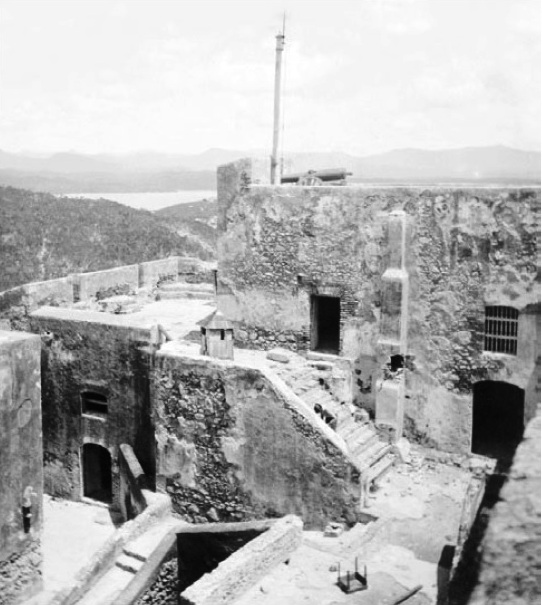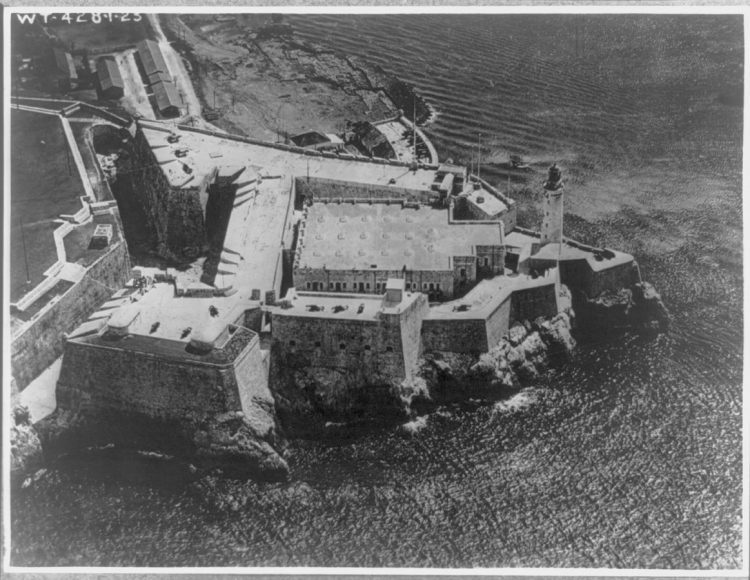Morro Castle – a 16th-century fortification that is situated at the entrance to the harbor of Santiago de Cuba. Also known as Castillo de San Pedro de la Roca, Castillo del Morro, San Pedro de la Roca Castle, and simply the Morro, the redoubt sits atop a bluff 207 feet high on the eastern headland of the harbor’s entrance some six miles south of the city of Santiago itself.
The Spanish began construction of the fort in the 16th century as part of a network of batteries at the mouth of the harbor and along the approximately 400-foot-wide channel that leads to it. During the Spanish-American War, Morro Castle was garrisoned by 411 soldiers and served as an observation post, an artillery position, and a prison.
During the war, the castle’s handful of antiquated guns rarely fired at U.S. Navy ships, but the presence of the castle and the surrounding batteries was a consideration in the U.S. plans to bottle up Admiral Pascual Cervera y Topete’s squadron in the harbor by sinking the collier Merrimac in its narrow approach channel.
An idea to trick the defenders into thinking it was a Spanish ship was rejected in favor of moving the blockship surreptitiously into position, in part because of the fort’s close proximity. During the actual mission on June 3, 1898, the mission commander, Navy lieutenant Richmond Pearson Hobson, decided to forego the gradual approach and order full steam when the castle’s profile could be clearly seen in the early dawn and he became convinced that the ship must have been observed from only 2,000 yards away.
The expedition ultimately failed, and the ship’s skeleton crew, including Hobson, was captured and interred in Morro Castle. Intelligence from Cuban insurgents, however, revealed the location of the prisoners, so the American ships that bombarded other defenses on June 6 and again on June 16 did not target the castle. It received only incidental damage in the actions. Lookouts on the castle were the first Spaniards to observe the dozens of ships that made up the American invasion fleet, and it was from the fort that Cervera learned of their presence.
A sentinel on the castle also reported the departure of Rear Admiral William T. Sampson’s flagship, the New York, from the blockading squadron outside the harbor’s entrance on July 3. Morro Castle was probably most important as a deterrent. Sampson was unwilling to send his ships through the Spanish defenses along the narrow approach to attack Cervera in his harbor refuge. Although Sampson believed that a determined bombardment could have silenced all of the castle’s batteries, he was also very concerned about mines in the channel controlled by onshore installations.
Morro Castle still stands today more than 500 years after its construction. In 1997, the United Nations Educational Scientific and Cultural Organization (UNESCO) declared it and its associated works a World Heritage Site as the largest and most complete example of European Renaissance military architecture.
Read More – Rappahannocks – A small, Algonquian-speaking Native American group


Originally posted 2022-05-10 05:26:10.